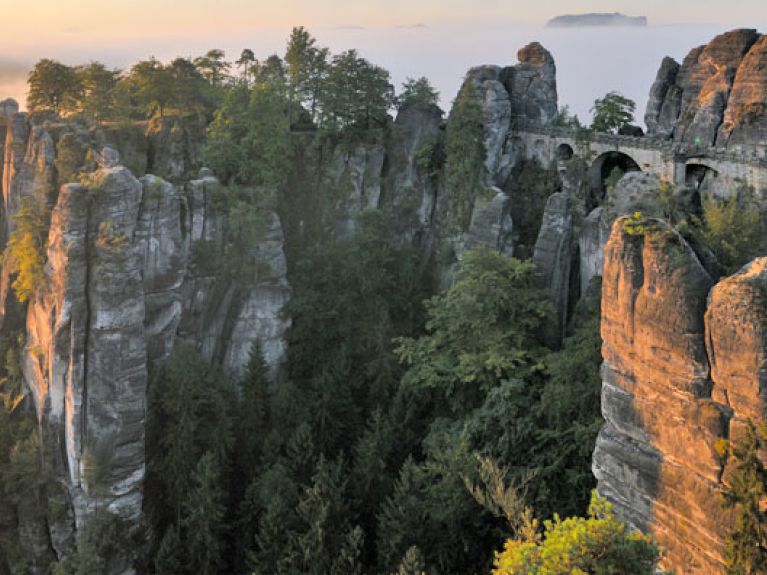Eastern Germany is trendy
The five federal states of eastern Germany are becoming increasingly popular with international visitors, and there are many good reasons for this.

The tiger cat is determined to be in the photograph. It simply jumps up onto the street café bench and right into the middle of the unique panorama – as if it had arranged it all: the mighty Gothic church, the lavishly refurbished old city centre, the view of the small river and its green banks. You might even think you were in Italy, were it not for the name “Neiße” in large letters on the sign. Who would have thought Germany’s eastern-most city would look so southern. Görlitz certainly comes as a surprise – with its Mediterranean charm and its romantic setting. At the same time, the city is just as was to be expected: full of history and stories. Little wonder that it has become difficult to find a hotel room there. Word has got round that a visit to the so-called “Europastadt” is worth the trip. The number of overnight stays here in the year 2012 increased by about 14%.
Study: about 36% more foreign tourists by 2020
Görlitz, with its 4,000 historical buildings, is not the only place enjoying a constant increase in visitor numbers. What applies to that “pearl of Saxony” has long since applied to the whole of eastern Germany: the region is trendy among tourists, attracting the interest of holiday-makers with Caribbean-white beaches, primeval forests, lakes and rivers, modern wellness and sport facilities, groups of half-timber houses, lots of history and culture of international rank. Foreign guests are discovering the appeal of the five eastern federal states. One study forecasts an increase of 36% in foreign tourists, meaning about 600,000 additional overnight stays by the year 2020.
This increase is due to a harmonious composition of tourist attractions in which each element is also unique. For example, Mecklenburg-Western Pomerania in the north takes the lead when it comes to something that is quite obligatory on any holiday, good weather. A total of 2,158 hours of sun have been recorded in Darßer Ort on the Fischland-Darß-Zingst peninsula, which is 500 more than the German average. And these hours of sun can be enjoyed along “Meck-Pomm’s” more than 1,712 kilometres of coastline. The romantic visitor is also catered for in this federal state criss-crossed by 2,588 kilometres of tree-lined avenues, broad meadows and woods, all doing their best to ensure that guests feel as removed as possible from the hustle and bustle of everyday life.
Art and architecture, lakes and forests
Saxony also has a lot to offer: in the form of Görlitz, and that Gesamtkunstwerk of Baroque architecture Dresden, and Meißen, home of Europe’s oldest porcelain manufactory, and the trade-fair city of Leipzig, one of the big winners, in terms of eastern German tourism, with an increase of 16.2% overnight stays. The southern tip of this federal state has an element of the fairytale about it: on the “cultural island” of Einsiedel visitors can live like the trolls who supposedly populate the area – that is to say, in little wooden houses high up in trees.
It is said of Brandenburg that there’s more sand there than people, and more lakes than towns. And sure enough, you will find sufficient numbers of streams, deciduous forests, bogs, fishponds, fields, meadows with scattered fruit trees, cottage gardens, ravines and valleys there. The Kneipp cures available in the small town of Buckow are at least as famous as the town’s former inhabitants Bertolt Brecht and Helene Weigel. The more active tourist has also not been forgotten: the melt water valley called the Baruther Urstromtal has the longest inline skating route in Germany – 190 kilometres of pristine asphalt.
Nothing beats trying it out yourself
Thuringia, with the Classic City of Weimar and with Eisenach, birthplace of Johann Sebastian Bach, has among its attractions one of the largest integral forest areas in the Republic. On the Rennsteig, a particularly lovely hiking trail, you can cover all of 168 kilometres, and as Goethe once claimed, you have only really been somewhere, when you have been there on foot. An additional culinary tit-bit along that route is the Deutsche Bratwurstmuseum in the municipality of Wachsenburg, between Eisenach and Gotha.
Finally there is Saxony-Anhalt, the federal state with medieval Hanseatic cities and natural idylls that seem not to have changed at all since the time of Emperor Karl IV – who lived in the 14th century. According to the magazine Geo, that ruler travelled here “because of the magnificent perfume of the flowers and herbs and the beautiful meadows”. This list of reasons for a trip to eastern Germany could be continued. Each of the five new federal states has its own charm and almost unlimited possibilities of appealing to visitors’ tastes. It’s worth giving them a try.
© .de - Deutschland.de, www.deutschland.de